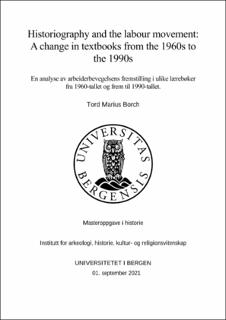En analyse av arbeiderbevegelsens fremstilling i ulike lærebøker fra 1960-tallet og frem til 1990-tallet.
Master thesis
Permanent lenke
https://hdl.handle.net/11250/2789459Utgivelsesdato
2021-10-13Metadata
Vis full innførselSamlinger
- Master theses [240]
Sammendrag
History as a field of study is in an everchanging state where the ways of approaching different themes are practically endless. Historiography has contributed to this understanding of how historians are writing history differently based on their historical period and their interest. The Norwegian historiography went through a radical change in the 1970s with an introduction to a broad new selection of directions, such as social history and women’s history. In this thesis I aim to bring attention to how social history and women’s history and gender history have contributed to the change in how authors highlight the labour movement in their textbooks from the 1960s until the 1990s in Norway. This work consists of a total of eight textbooks from before, during and after the 1970s historiographical change. In these textbooks I focused on the Norwegian and the English labour movement from their creation to the period after the first World War. I applied a set of aspects to the labour movement to aid my perspective of the potential changes that was to occur. The aspects consist of: the political and the union side, the radical and the moderate side, ideology connected to the labour movement, the gender dimensions, the material basis and how it affects change and lastly, the presentation of different actors and how they affect change. These aspects of the labour movement were then compared between the different books to see if there were any changes connected to the different historiographical periods. With aid from Grove & Heiret and Larsen in the book Fortalt fortid (which looks at how the narrative in different historiographical trends change), I attempted to uncover a pattern with the founds from the textbooks with the changes in social history and women’s and gender history in the same period. The results suggest that all the books implement the history of the labour movement and workers. They are therefore in different ways connected to social history by writing history from “bellow”. The books are showing social historical signs but are not in any way social historical works as the books are not themselves deeply emerged in the topic of people, in terms of as social and cultural phenomena. The clearest change was connected to the aspect of women and gender, which shows a change in the 1970s as one of the two books included women connected to the labour movement. The books from the 1980s and 1990s both include women in this manner. A change in the books from the 1990s also occur as women are perceived as passive and are no longer included as a part of the labour movement - and they are no longer described as part of a union or a labour party.
